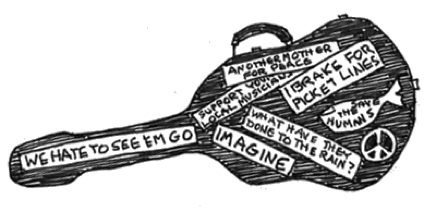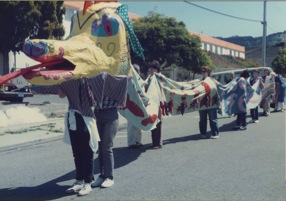


I
woke up at five this morning from a dream of chancing upon a Hiroshima
Day commemoration in a park and ditching whatever errand I’d been on to
join it. I tried to go back to sleep, but I was wondering what day it
was, thinking I’d probably missed Hiroshima Day entirely. I got up a
little after six and checked the date. August 6: Hiroshima Day. All the
information I need is there in my brain if I could only access it. When I
needed to access it was yesterday, so I could have arranged to go with
the Berkeley folks to the commemoration that started ten minutes ago in
front of the Livermore Lab. I’ve gone to it in years past, or to the one
in Japan Town in San Francisco. I guess this year I’m commemorating it
online with you-all.
We didn’t stop in Hiroshima when I went along on my mother’s tour of Japan in 1970.
We did pass through it on the train on our way to one of her gigs. But
I’ve always felt a special attachment to Japan since then and have tried
to do something each August to remember the destruction of Hiroshima
and Nagasaki by atomic bombs. Here in Berkeley, the children’s room at
the public library has a reading of Sadako and the Thousand Paper Cranes
and a crane-folding, but it’s when I usually meet my friend Emily to
write, so I think I’ll just fold a few cranes at home and drop them off.
They will be sent to the Children’s Peace Monument in Japan. The statue
there of Sadako bears the inscription I’ve used as a headline today.

Meanwhile,
on the other side of the world, Japanese-Americans soldiers were
fighting our other enemies, Germany and Italy, in a segregated US Army.
My old friend (from third grade) Margaret sent me a book about them
months ago and I just got around to reading it. Just
Americans: How Japanese Americans Won a War at Home and Abroad, The
Story of the 100thBattalion/442d Regimental Combat Team in World War II
by Robert Asahina. The irony, of course, is that back home, their
families were in relocation camps, while Italian-American and
German-American citizens were not. I admit I skipped the middle of the
book where their valor in combat was described, but the first and last
parts, about the prejudice they suffered before and after the war, was
illuminating. I was six when the war started, and my only memory of the
relocation was that we bought a piano from a family being moved away.
To
underscore the lack of military necessity for the relocation,
Japanese-Americans in Hawaii, which had actually been attacked, were not
relocated. They were too large a part of the population there, and
their labor was needed to rebuild Pearl Harbor, among other things. I
knew that; what I didn’t know was that when the soldiers from Hawaii
(The 100th) were combined with those from the Mainland (the 442d) there
was friction. Partly this was a difference in lifestyle, partly it was
that the recruits from Hawaii didn’t understand why many mainland
Japanese-Americans did not sign up—until they were taken on a visit to
one of the camps. Then they could understand the resentment, and the
combat team became a team.
©2009 by Nancy Schimmel

Thursday, August 6, 2009

THIS IS OUR CRY. THIS IS OUR PRAYER.
PEACE IN THE WORLD.







